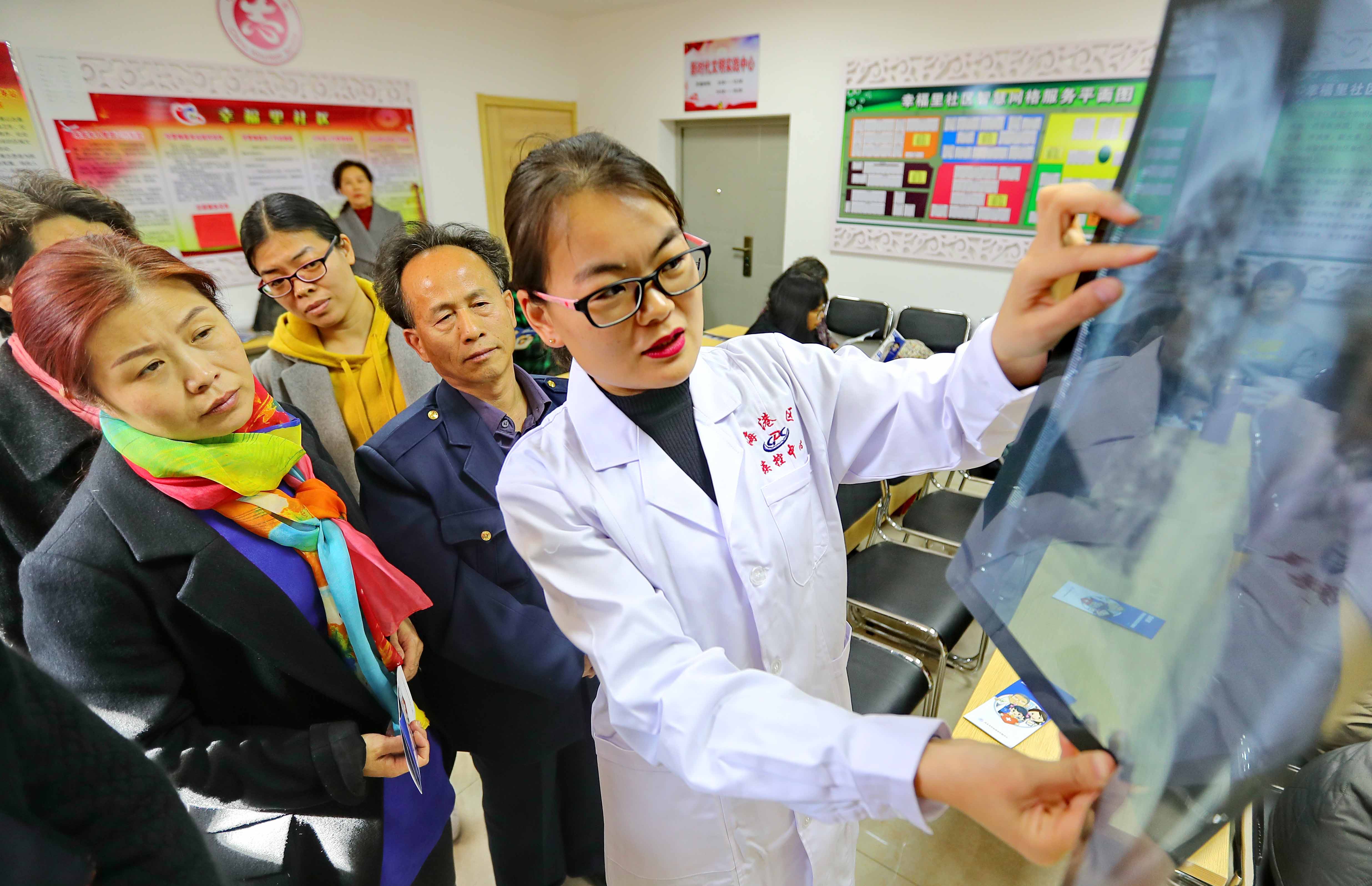Goal to reduce cases of TB is within reach
Getting under 55 per 100,000 possible, but WHO target daunting, experts say


The short-term goal of reducing the incidences of tuberculosis in China to under 55 per 100,000 people by 2022 is within reach despite setbacks dealt by the COVID-19 pandemic that underscored the need to enhance the resilience of TB services, public health experts said.
But they said current control strategies are unlikely to be sufficient to help the country achieve low incidence-defined by the World Health Organization as fewer than 10 people per 100,000-by 2035. The WHO has set a target for the global average rate to be brought down to that level by then.
The experts urged more proactive screening among key groups and speedier creation of rapid and accurate diagnostic tools to accelerate progress.
Huang Fei, a TB researcher at the Chinese Center for Disease Control and Prevention, said regular TB prevention and control work in China resumed swiftly after the COVID-19 pandemic was brought under control, as manifested by an increase in hospital visits by those with telltale symptoms and a rise in newly detected cases since early April.
"The notification rate of TB patients rebounded to normal levels in the 10th week after Spring Festival (Jan 25) this year and has remained steady as patients affected by the novel coronavirus outbreak rushed to hospitals for examination," he said.
In previous years, the number of newly detected TB cases decreased sharply in the first week after Spring Festival-the traditional Chinese New Year holiday-and bounced back to normal levels in the second week, according to a study led by Huang that was published in October in medical journal Lancet Regional Health-Western Pacific.
This year, the rebound took longer because 75 percent of CDC workers and grassroots healthcare workers were assigned to fight the COVID-19 pandemic, and nearly 15 percent of TB clinical services were halted at the height of the outbreak. Travel restrictions also hampered or delayed planned hospital visits, according to the study.
Hospitals specializing in the treatment of patients with TB, a primarily respiratory disease, were also better suited to receiving COVID-19 patients than other hospitals.
"Now, except for sporadic novel coronavirus infections discovered in isolated regions, large parts of China have resumed production and normal lives, exerting little impact on TB control," Huang said.
According to the National Health Commission, the incidence of TB infections in China declined from 70.6 per 100,000 in 2012 to 59.3 per 100,000 in 2018.
Huang said it dropped to 55.5 per 100,000 people last year, edging very close to the 2022 target proposed by the commission and seven other government departments in June 2019.
To meet the goal, Huang stressed that TB healthcare service providers should improve their ability to cope with health emergencies and provide uninterrupted diagnosis, treatment and management services under all circumstances.
"Specific work will entail appraisal and stocking of adequate amounts of TB drugs, diagnostic antigens and protective equipment, cultivating more TB prevention and control talent and adopting remote and smart technologies to expand access to services in remote areas," he said.
Most cases of TB are curable, but a formidable barrier is the prevalence of drug resistance, a deadlier condition that occurs when treatment regimes are interrupted or not strictly followed by patients.
Wang Qiaozhi, deputy head of the Hunan Institute for Tuberculosis Control, urged local disease control officials to thoroughly screen TB patients who missed hospital visits or discontinued therapies during the COVID-19 outbreak and follow up on their future management.
To tackle drug-resistant TB, the National Health Commission launched a program in partnership with the Bill and Melinda Gates Foundation in 2009 that is piloting innovative diagnostic methods and new drugs in three provincial-level regions.
In these regions, the cure rate for drug-resistant TB patients has risen to 95 percent, compared with an average of 50 percent in places with traditional treatment regimes, the commission said.
The global outlook for curtailing and eliminating TB infections appears daunting, with the Global Tuberculosis Report released by the WHO in October concluding that by the end of last year, many countries were not on track to meet interim targets on the path to their 2035 goals.
It said the COVID-19 pandemic threatened to derail progress made in tackling TB, adding that the global target of a 95 percent reduction in TB incidences from the level seen in 2015 by 2035 could not be met without intensified research and innovation.
"Technological breakthroughs are needed by 2025," it said.
Chen Shiming, secretary-general of the Chinese Anti-Tuberculosis Association, told a recent forum that from 2010 to 2018, the TB incidence rate in China declined more quickly than the global average, but the rate of improvement would have to quadruple to hit the low incidence rate of 10 per 100,000 by 2035.
Last year, 54 countries, mostly in the Americas and Europe, hit that target and are well-positioned to eliminate TB by 2035, according to the WHO report.
China is one of 30 high-TB-burden countries identified by the WHO.Last year, it accounted for 8.4 percent of the estimated number of new TB cases around the world and 14 percent of drug-resistant infections, the WHO report said.
Thanks to efforts to expand access to timely and effective treatment, the death rate for TB patients in China dropped to the lowest among all high-burden countries for the first time last year, the report said.
Three years ago, China CDC official Jiang Shiwen, who has since retired, told a news conference the country's annual spending on TB control had risen about 15 times in the previous two decades and was running at about 600 million yuan ($91.4 million) a year.
Li Liang, vice-president of Beijing Chest Hospital, suggested recently that widespread screening of key groups-the elderly, students and people with weak immune systems-should be piloted in some well-developed regions in the next five years to explore innovative ways of proactively detecting TB infections.
Wang said that in 2017, TB infections detected among senior high school students in Hunan accounted for over 65 percent of all cases on campuses. "Hunan has already encouraged conducting a round of TB screening covering students who are about to enter their final year of high school as an early intervention method," he said.
In mid-October, Jiangsu Normal University in Xuzhou, Jiangsu province, said it had detected 22 TB cases among its students from August last year to October this year, and 43 students had shown abnormal CT scan results after mass testing.
Given the span of time involved, the university's statement sparked concerns about the effectiveness of TB detection and reporting on campuses.
On Saturday, the National Health Commission released a guideline on controlling TB infections at schools, requiring all schools to include TB tests in health checks for newly enrolled students and in regular health examinations for teachers and staff members. Test results will be added to their health records, according to the document.
It added that when a school sees a cluster involving 10 or more TB cases in one semester, or reports deaths caused by TB infections, local health officials will launch an investigation to decide if the outbreak amounts to a health emergency.
"The TB epidemic in China has been trending downward in recent years but remains very serious," it said. "Schools are at higher risk of seeing the spread of TB infections."
Li said he is hopeful that rapid testing kits capable of yielding results by analyzing one breath or a drop of blood will be rolled out in the next five years. "We always need faster, more accurate and affordable diagnostic tools," he said.
- Global influencers explore beer city at Qingdao WCNA
- Heavy rainstorm leaves three dead, four missing in Hebei resort
- Ethnic integration on the grassland
- China renews alerts for rainstorms, high temperature
- Beijing restores power, communications, water-supply to flood-hit villages
- Helicopter sightseeing project takes off over Wuliangsu Lake





































